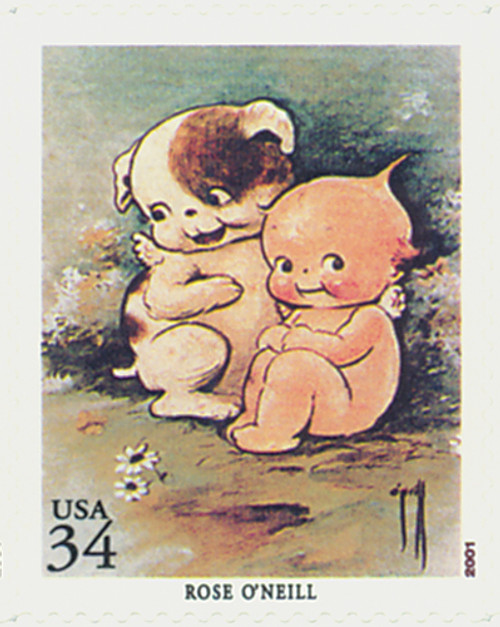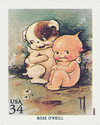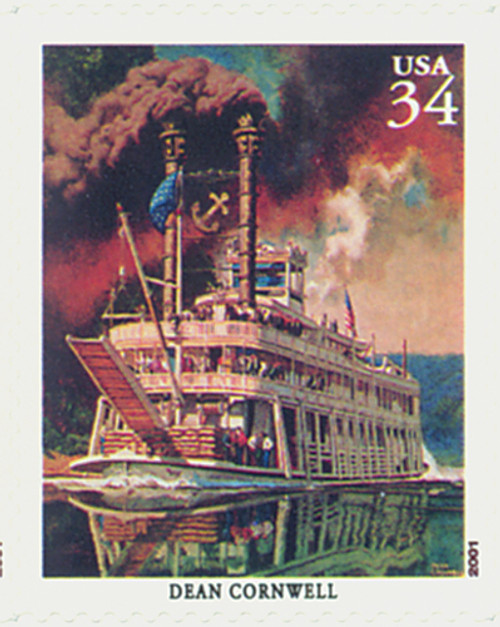
# 3502i - 2001 34c American Illustrator Rose O'Neill
Rose O’Neill
34¢ American Illustrators
City: New York, NY
Quantity: 125,000,000
Printed by: Avery Dennison Security Printing
Printing Method: Photogravure
Perforations: Serpentine die cut 11.25
Color: Multicolored
Birth of Rose O’Neill
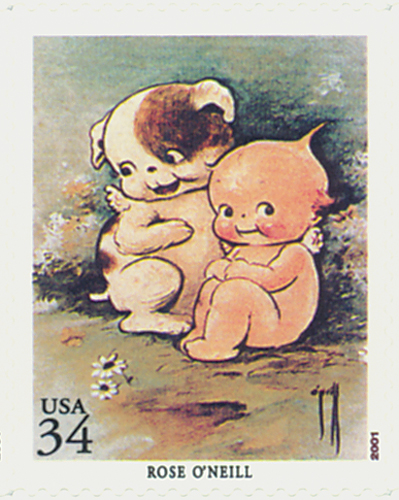
Illustrator and writer Rose Cecil O’Neill was born on June 25, 1874, in Wilkes-Barre, Pennsylvania. O’Neill was the highest-paid female illustrator of her time, most famous for creating Kewpie, the most well-known cartoon character until Mickey Mouse.
O’Neill was the daughter of a bookseller and teacher/musician. She displayed a joy and talent for art and writing at a young age and entered a children’s drawing competition when she was 13. She won first prize. The judges of that art competition worked for local periodicals and helped O’Neill find work providing illustrations several Omaha publications. The income she received help to support her family.
In 1893, O’Neill’s father decided to take her to New York to find better opportunities. They stopped at the World’s Columbian Exposition along the way, where O’Neill saw large paintings and sculptures in person for the first time – previously she had only seen them in books.

In New York, the 15-year-old O’Neill lived at the Sisters of St. Regis convent. The nuns went with her to sell her work to publishers. She sold several drawings and was commissioned to create more. Her illustrations were featured in True magazine on September 19, 1896, making her the first published American woman cartoonist. Soon, O’Neill was the only woman on the staff at Puck magazine, and she also provided illustrations for Harper’s and Life plus advertisements for Jell-O.

O’Neill moved to Missouri to be with her family and illustrated two books for her then-husband and assistant editor at Puck magazine – The Lions of the Lord (1903) and The Boss of Little Arcady (1905). O’Neill wrote and illustrated her own novel, The Loves of Edwy, in 1904. One reviewer said her illustrations possessed “a rare breadth of sympathy with and understanding of humanity.”
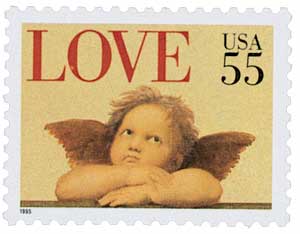
In 1908, O’Neill created her “Kewpie” characters, whimsical cherubs based somewhat on Cupid, the Roman god of love. O’Neill dreamt about the characters and said that they were “a sort of little round fairy whose one idea is to teach people to be merry and kind at the same time.” Her Kewpies first appeared in a comic strip in Ladies’ Home Journal in 1909, followed by Woman’s Home Companion and Good Housekeeping.
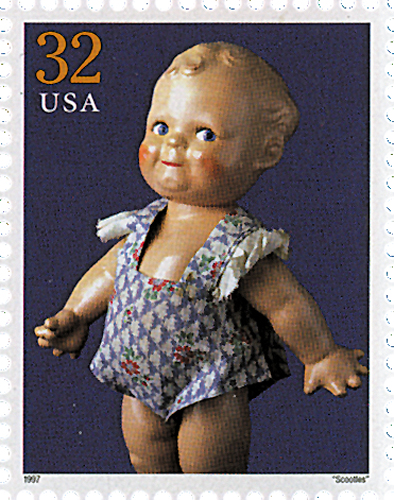
The Kewpies became popular very quickly and in 1912, a German porcelain company began producing Kewpie dolls. Later versions of the dolls were the first mass-marketed toys in America. Kewpies were eventually included in the advertisements for Jell-O, Kellogg’s Corn Flakes, and Sears as well as many home goods including dishware, rattles, soap, stationery, and more. The success of Kewpies made O’Neill a millionaire, but she continued to work.
O’Neill was active in the women’s rights and suffrage movement and was the inspiration for the song “Rose of Washington Square.” She studied sculpture under Auguste Rodin. Her sculptures were largely inspired by her dreams and mythology and were exhibited in New York and Paris.
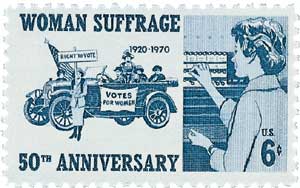
O’Neill spent her later years at the family home, Bonniebrook, in Missouri. She had lost most of her fortune supporting her family and friends and investing in properties. By the 1940s, her Kewpies were no longer popular, and photography began replacing illustration. O’Neill died on April 6, 1944. Her family home was added to the National Register of Historic Places in 1997 and she was inducted into the National Women’s Hall of Fame.
Rose O’Neill
34¢ American Illustrators
City: New York, NY
Quantity: 125,000,000
Printed by: Avery Dennison Security Printing
Printing Method: Photogravure
Perforations: Serpentine die cut 11.25
Color: Multicolored
Birth of Rose O’Neill

Illustrator and writer Rose Cecil O’Neill was born on June 25, 1874, in Wilkes-Barre, Pennsylvania. O’Neill was the highest-paid female illustrator of her time, most famous for creating Kewpie, the most well-known cartoon character until Mickey Mouse.
O’Neill was the daughter of a bookseller and teacher/musician. She displayed a joy and talent for art and writing at a young age and entered a children’s drawing competition when she was 13. She won first prize. The judges of that art competition worked for local periodicals and helped O’Neill find work providing illustrations several Omaha publications. The income she received help to support her family.
In 1893, O’Neill’s father decided to take her to New York to find better opportunities. They stopped at the World’s Columbian Exposition along the way, where O’Neill saw large paintings and sculptures in person for the first time – previously she had only seen them in books.

In New York, the 15-year-old O’Neill lived at the Sisters of St. Regis convent. The nuns went with her to sell her work to publishers. She sold several drawings and was commissioned to create more. Her illustrations were featured in True magazine on September 19, 1896, making her the first published American woman cartoonist. Soon, O’Neill was the only woman on the staff at Puck magazine, and she also provided illustrations for Harper’s and Life plus advertisements for Jell-O.

O’Neill moved to Missouri to be with her family and illustrated two books for her then-husband and assistant editor at Puck magazine – The Lions of the Lord (1903) and The Boss of Little Arcady (1905). O’Neill wrote and illustrated her own novel, The Loves of Edwy, in 1904. One reviewer said her illustrations possessed “a rare breadth of sympathy with and understanding of humanity.”

In 1908, O’Neill created her “Kewpie” characters, whimsical cherubs based somewhat on Cupid, the Roman god of love. O’Neill dreamt about the characters and said that they were “a sort of little round fairy whose one idea is to teach people to be merry and kind at the same time.” Her Kewpies first appeared in a comic strip in Ladies’ Home Journal in 1909, followed by Woman’s Home Companion and Good Housekeeping.

The Kewpies became popular very quickly and in 1912, a German porcelain company began producing Kewpie dolls. Later versions of the dolls were the first mass-marketed toys in America. Kewpies were eventually included in the advertisements for Jell-O, Kellogg’s Corn Flakes, and Sears as well as many home goods including dishware, rattles, soap, stationery, and more. The success of Kewpies made O’Neill a millionaire, but she continued to work.
O’Neill was active in the women’s rights and suffrage movement and was the inspiration for the song “Rose of Washington Square.” She studied sculpture under Auguste Rodin. Her sculptures were largely inspired by her dreams and mythology and were exhibited in New York and Paris.

O’Neill spent her later years at the family home, Bonniebrook, in Missouri. She had lost most of her fortune supporting her family and friends and investing in properties. By the 1940s, her Kewpies were no longer popular, and photography began replacing illustration. O’Neill died on April 6, 1944. Her family home was added to the National Register of Historic Places in 1997 and she was inducted into the National Women’s Hall of Fame.

